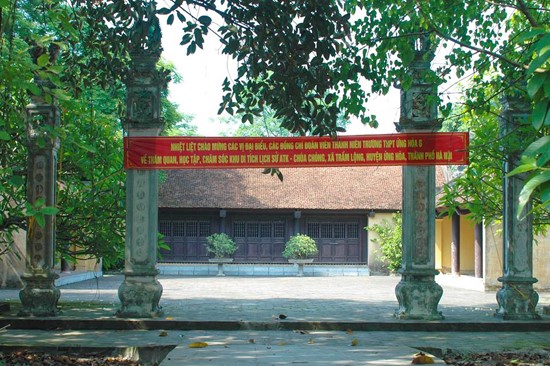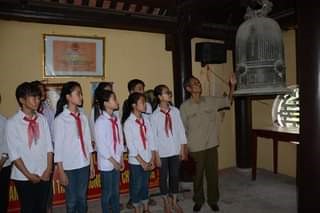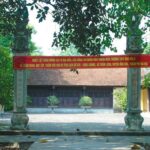Chua Chong (commonly known as Tram pagoda) is an ancient pagoda, built in the Le Dynasty (year Giap Than – 1764), located in Tram Long village, Ung Hoa district. With its position as the Center of the Safe Zone of the Tonkin Party Committee, a particularly important historicl evidence, in 2000, Chong Pagoda was officially recognized as a national revolutionary historical relic with the name “Revolution Relic of Safe Zone of the Tonkin Party Committee – 1942 Chong Pagoda – Tram Long”.

Chong Pagoda. Photo: Thanh Tu
Chong pagoda consists of 5 Shrine halls and 1 harem, behind is the Ancestral House. According to many sources, the bell of Chong pagoda was cast in 1975. The bell is 1.12m high; weighs 125kg; bottom diameter 0.58m. The Chinese characters carved around the bell record the year of casting and record the merits of Buddhists who contributed to the bell casting. The sound of the bell echoes far away and the people in the area have a saying: “Tram bell, Bai tocsin, Ngam village’s drum” to express the value of the bell and the meaning of the sound of “Tram bell”.
During the period from 1942-1945, Chong Pagoda was selected as the safe zone of the Party Committee. The people of Tram Long commune had hidden and protected many high-ranking officials from the Central Committee, the Regional Party Committee and the Provincial Party Committee of Ha Dong, such as comrades Truong Chinh, Hoang Van Thu, Hoang Quoc Viet, Do Muoi…

Teaching traditions for the young generation at Chong Pagoda (photo taken before the COVID-19 epidemic)
On January 10, 1943 (lunar calendar), elderly female bonze Dam Nhan, the abbot of the pagoda, passed away, the Party Branch at Tram Long led all members of Association of Elders, with Mr. Ly Pham and Mr. Chu Dan as the key persons, invited bonze Lam – a revolutionary individual in Kim Giang to head the work of the pagod. The revolutionary force base at Chong Pagoda continued to be consolidated, serving as a place to pick up and drop off officials from the Party Committee and the Central Committee…The more people had fought, the more boiling the revolutionary spirit in Tram Long had become. The pagoda is still a station for inter-transportation, hiding and nurturing cadres that went back to their homeland to operate. Every night, there was a patrol force, guarding the pagoda area. At the meeting of the Provincial Party Committee, on March 18th, 1945, in Vien Noi village, after thoroughly studying and discussing the plan to implement the directive of the Standing Committee of the Party Central Committee on “Japan and France fought each other and our actions “. The meeting had assigned Comrade Do Muoi, Provincial Party Committee member in charge of the South of Ung Hoa and My Duc districts. After the meeting of the Provincial Party Committee, comrade Do Muoi returned to Tram Long, taking this place as the center, thereby directing the revolutionary movement in southern Ung Hoa and South My Duc. Chong pagoda has become the focal point of contact in meetings and rehearsals for the general uprising.
On August 10th, 1945, during the struggle against Japanese soldiers who went to plunder rice in Trach Xa (Anng Hoa), comrade Do Muoi had rung the bell of Chong pagoda as a signal, calling upon the people and forces of Tram Region to fight together, and had captured the enemy’s security guard squad, bringing the struggle to victory. On the morning of August 17th, 1945, comrade Do Muoi had read the Military Order of Uprising, mobilized mass of people from all over the region to attack and occupy the governor’s office, taking control of Ung Hoa. Comrade Do Muoi rang the long bell, which was an order for armed uprisings to seize power in Ung Hoa. After the pagoda’s bell rang, people and the armed forces of Tram gathered in neat ranks, hurried to Tao Khe village, joined forces with groups of friends and comrades from Dai Bai, Phu Luu, and Dao Tu. … listen to Comrade Do Muoi reading the Military Order of Uprising, disseminate the plan to invade the province. As soon as the order was finished, Tram Long’s army and friends’ unit moved to Hoang Xa, quickly storming in and occupying the governor’s office. The uprising to occupy Ung Hoa was victorious. On August 18th, 1945, the people of Tram Long commune held a rally to celebrate the victory at Chong pagoda, established the provisional revolutionary committees of villages, confiscated seals and books of the former government.
For many years, the image of Chong pagoda and the ringing bell has been imprinted in the mind and pride of the people of Tram Long in particular and Ung Hoa district in general. This is a place chosen by many tourists near and far because of its beauty in architecture and is a particularly important evidence of history.
In 1951, during a big raid, the French colonialists bombed and bombarded the pagoda, resulted in burning it down. In the years 1993 – 1995, Tram Long people contributed to rebuilding the pagoda on the old ground.
For many years, the image of Chong pagoda and the ringing bell has been imprinted in the mind and pride of the people of Tram Long in particular and Ung Hoa district in general. This is a place chosen by many tourists from near and far because of the beauty in architecture and the value of a particularly important historical evidence./.
Hà Thanh

